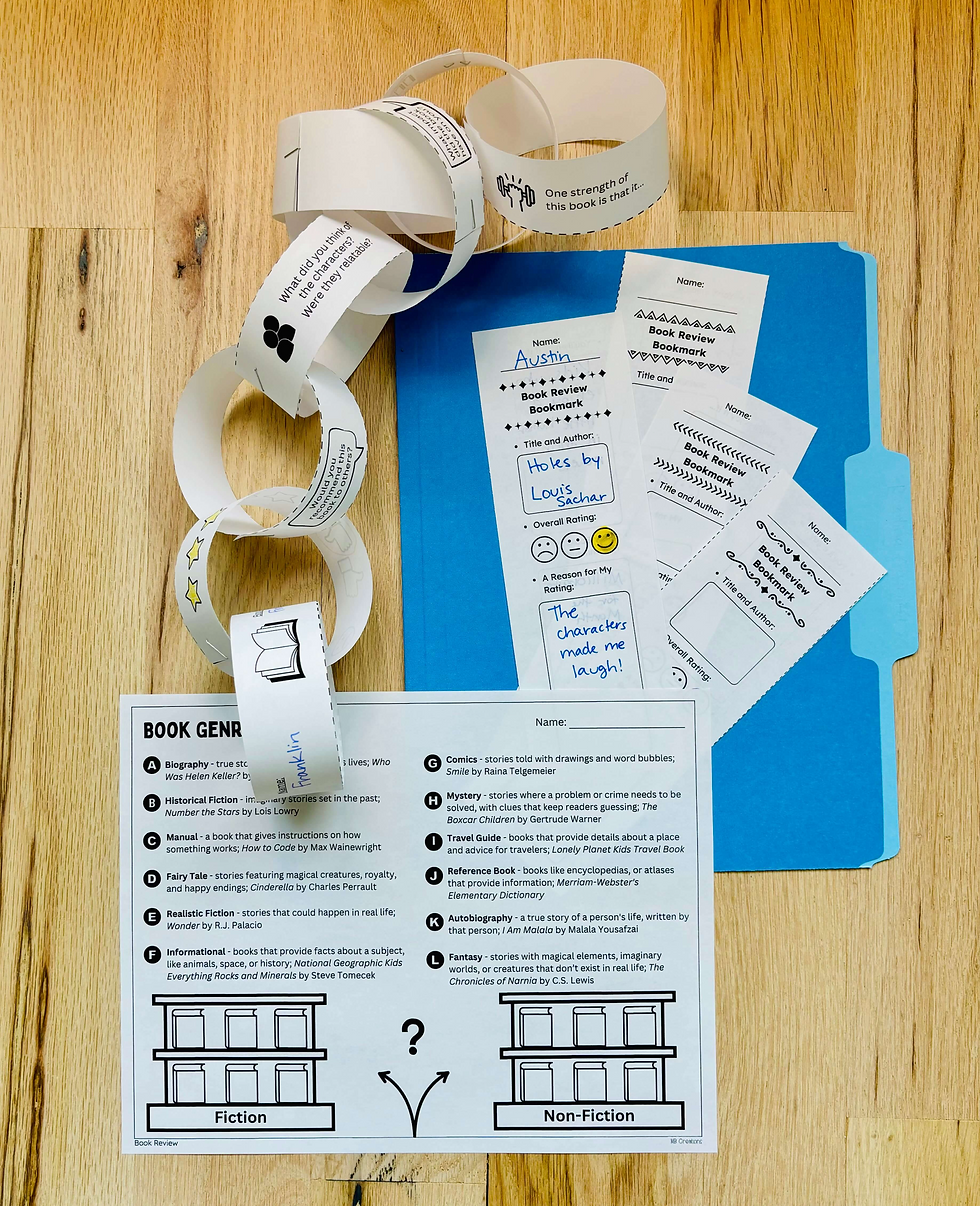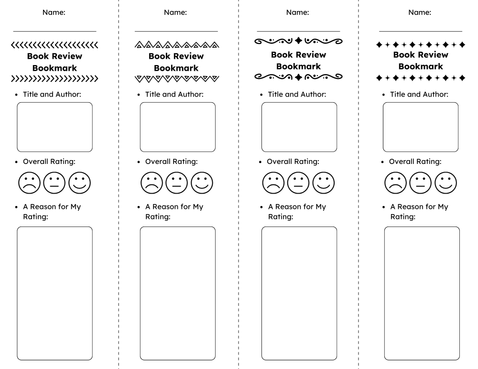Bring Reading to Life with Book Recommendations
- Megan Bell Smith
- Sep 13, 2024
- 5 min read
Updated: Oct 25, 2024
Let’s try a little experiment: count how many times your students ask, “What can I do now?” in just one week. (Some of you might not even make it past a single day before filling a sticky note with tally marks!)
When I first started teaching a self-contained gifted and talented fourth-grade class, I naively thought, “This will be easier than teaching a general education class—my students will all be at similar ability levels.” Boy, was I wrong! The range of abilities in my classroom still stretched from 2nd to 7th grade. On top of that, I had students who finished their work in the blink of an eye and others who needed more time to process. I quickly realized I needed engaging activities that could keep every student challenged and excited about learning throughout the day. That’s when I discovered the power of creative book projects! #classroombookreviews
Many teachers find themselves searching for engaging activities that spark a love of reading in their students—especially those early finishers and gifted learners who need a little extra challenge. Your students will thank you for offering choice. They want to choose their own novels to read and choose their own projects. If traditional book reports feel like a creativity killer, turn what should be an exciting journey through literature into a cherished assignment. These flexible, ready-to-go ideas can seamlessly fit with every book. #bookrecommendationtemplates
Small Group Sharing
Invite students to report on a favorite book in small group literature circles. Let’s be honest—listening to thirty book report speeches can be tedious, even for teachers! By having students share in smaller groups, they still get valuable practice presenting, while everyone avoids spending an entire afternoon listening to lengthy presentations. Students can keep a list of books that catch their interest, giving them plenty of ideas for what to read next. If tracking participation and active listening is important to you, ask students to write down the name of the presenter, their book title and author, and a 1-sentence summary of their review.
Book Recommendation Bookmarks
Add book recommendation bookmarks to your classroom library. Consider storing these inside the front covers of chapter books or attaching them with a metal ring in the corner. Students can reference bookmark reviews when searching for something new to read. Cut apart construction paper and make a model with your students, print out a ready-to-use template below, or add your own questions by editing this bookmark recommendation file. One of my students enjoyed saving her bookmarks to make a miniature portfolio of all the novels she read during fourth grade. She even evaluated each one at the end of the year to pick her all-time favorite.
Book Recommendation Projects
Students' learning is significantly enhanced by relevance. When the content and projects at school don’t connect to their lives, students often find it challenging to grasp the material and stay engaged. Since adults rarely present formal reports in everyday life, teaching students how to write reviews is far more practical. By crafting book reviews, students develop skills they can easily transfer to reviewing apps, products, movies, and much more. #bookreviews
Focus on the following:
Critical Thinking: Encourage students to analyze the plot, characters, themes, and settings deeply. Teach them to ask probing questions about the text, such as why characters make certain choices or how the setting influences the story.
Stating Opinions: Help students express their opinions clearly and support them with evidence from the text. This involves teaching them to differentiate between personal preferences and objective analysis.
Summarizing: Guide students in summarizing key elements of a novel concisely without giving away spoilers. They should learn to highlight the main plot points and themes while maintaining the reader's interest.
Writing Structure: Identify the structure of a good review, including an engaging introduction, a well-organized body with clear arguments, and a thoughtful conclusion. Teach students how to balance personal opinion with factual information.
Descriptive Language: Encourage the use of vivid, descriptive language to convey thoughts and emotions about the novel. This helps make their reviews more engaging and impactful.
Comparative Analysis: Teach students to compare the novel they are reviewing with other works by the same author, within the same genre, or with similar themes. This adds depth and context to their reviews.
Audience Awareness: Help students understand who their review is for and how to tailor their language, tone, and content to suit that audience, whether it's peers, teachers, or a broader readership.
Editing and Revising: Emphasize the importance of editing and revising to refine their writing. Teach students how to check for clarity, coherence, grammar, and spelling errors to ensure their reviews are polished and professional.
Persuasive Writing Techniques: Introduce persuasive writing techniques to help students craft compelling arguments that persuade others to read (or not read) the book. This includes using rhetorical questions, powerful statements, and emotional appeals.
Constructive Feedback: Encourage students to provide and receive constructive feedback on their reviews, fostering an environment of continuous improvement and growth.
Students can write a review on loose-leaf paper or type on a Google Slide. It can be fun to flip through the reviews for the class to examine during dismissal or when you have extra minutes before recess. Alternatively, you can replace book reports with book recommendation projects. My early finishers and gifted students especially loved creating paper chains and book brochures to tell about novels they read. Edit these Canva templates and adapt the projects to different student needs. #editablebookreports
Creative Projects Will Energize Your Students
My students never ceased to amaze me. One student coded a game that involved the characters, setting, and major events from his novel. Another baked planets from our solar system out of cake pops to share about her space novel. Another impressive book report project my class completed was book trailer videos. Students made short, engaging video trailers that summarized their books' plot and highlighted why each one was a great read. Peers enjoyed watching these videos in class because they were similar to watching movie trailers. You can bring popcorn or snacks to build excitement for this special event. It’s these creative projects that make reading come alive and truly showcase the incredible talents and imaginations of your students.
Learn How to Fold a 1-Page Miniature Book
Students can review novels they read in class by creating a one-page pocketbook. This incredible project saves on paper and leaves no trash on student desks. This means your classroom carpet can stay clean even though students are getting out their scissors!
Decorate Bulletin Boards with Books
Finally, I've found that my favorite bulletin boards are the designs I can leave up all year. One year I emphasized a reading goal of 20-minutes each night. If students turned in their completed monthly reading logs, they could join our bookworms club! They wrote their names on a construction paper circle and added it to our hallway bulletin board. Another year, I challenged my gifted and talented class to read 36 books during the 36 weeks of school. They loved decorating book spines to add to our bookshelf bulletin board. They felt motivated to keep up with their reading when they walked by the visual reminder each day. #readingbulletinboard
Integrating creative book projects not only revitalizes your reading curriculum, but also keeps students motivated and involved. After exploring ideas like small group sharing, book recommendation bookmarks, and various book review projects, you can further enhance your classroom environment with yearlong bulletin boards. These visual displays can celebrate your students' reading accomplishments and serve as ongoing reminders of their top-rated reviews.








